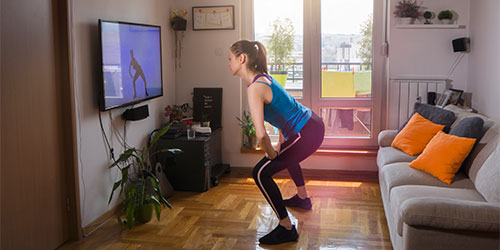Sport and physical activity at the heart of policy making

Sport and physical activity at the heart of policy making, by Dr Richard Medcalf, Director, Institute of Human Sciences.
It is widely accepted that physical activity is central to our health and well-being. What we have seen since the emergence of the COVID-19 global pandemic is a huge change in our personal and collective physical activity habits, with all now taking place either in the home or in social isolation in our local area. At the same time there appears to have been a renewed appreciation for the need for exercise and the benefits that it brings. For many, the direct relationship between our time being physically active and our mental wellbeing has never been clearer.
The social distancing measures imposed during lockdown have changed our exercise habits overnight. Our enjoyment of team sports has been replaced by physical activity with our families; our gyms and leisure centres replaced by both synchronous and virtual activity in the home. For those able to exercise outside of the home there are, of course, a range of options to do so, but for many (including those shielding from the virus) the options are few and reliant on a capability and willingness to engage with online instruction and/or self-motivation without the benefit of peer support or interaction. Although we hope for the current restrictions to be short lived they have the potential to change the leisure landscape for ever. Changing habits will likely have a huge impact on public sector leisure, historically considered non-statutory and thus at significant risk of further cuts if not graced with a renewed set of protections.
Our community sports clubs have been hit hard by social restrictions and the cessation of all grassroots sport. On a national level Sport England have received praise for their response to the virus focussed on the #Stayinworkout campaign. This has been distilled locally by Active Partnerships such as Active Black Country who have been central to regional landscape with some great support for our local sporting infrastructure. There are also further useful resources from both CIMSPA and UKActive which those within the sector will no doubt be utilising. However for the general public the loss of both grassroot and elite (spectator) sport has left a significant hole in the social fabric of what sport means to many.
As Government policy and public health guidelines evolve over the coming months it is becoming clearer that sport and physical activity will be central to the national response to COVID-19. Indeed it is now one of the first restrictions relaxed by governments, with a more permissive approach to more than one form of exercise per day in many countries. The implicit assumption therein that physical activity is at the heart of our response to the virus and thus the short term policy making agenda. For example we have seen a renewed importance placed upon active transport with a significant and welcome emphasis placed upon walking and cycling, including new statutory guidance on reallocating road space in our towns and cities.
Despite many decades of advocacy, the coronavirus has elevated physical activity and exercise and given a renewed focus to their well-established benefits. Those lobbying for physical activity have long attempted to hard wire it into “bigger ticket” policy agendas such as housing, digital and transport. We should now contend that it has an elevated status in its own right, although it is unclear whether this is a short-term focus or one which will sustain.
For more information please contact the Corporate Communications Team.


/prod01/wlvacuk/media/departments/digital-content-and-communications/images-2024/Diane-Spencer-(Teaser-image).jpg)
/prod01/wlvacuk/media/departments/digital-content-and-communications/images-18-19/220325-Engineers_teach_thumbail.jpg)
/prod01/wlvacuk/media/departments/digital-content-and-communications/images-2024/241024-Dr-Christopher-Stone-Resized.jpg)
/prod01/wlvacuk/media/departments/digital-content-and-communications/images/Maria-Serria-(teaser-image).jpg)
/prod01/wlvacuk/media/departments/digital-content-and-communications/images-2024/241014-Cyber4ME-Project-Resized.jpg)
/prod01/wlvacuk/media/departments/digital-content-and-communications/images-2024/240315-Research-Resized.jpg)
/prod01/wlvacuk/media/departments/digital-content-and-communications/images/Kabaddi-WC-(teaser-image).jpg)